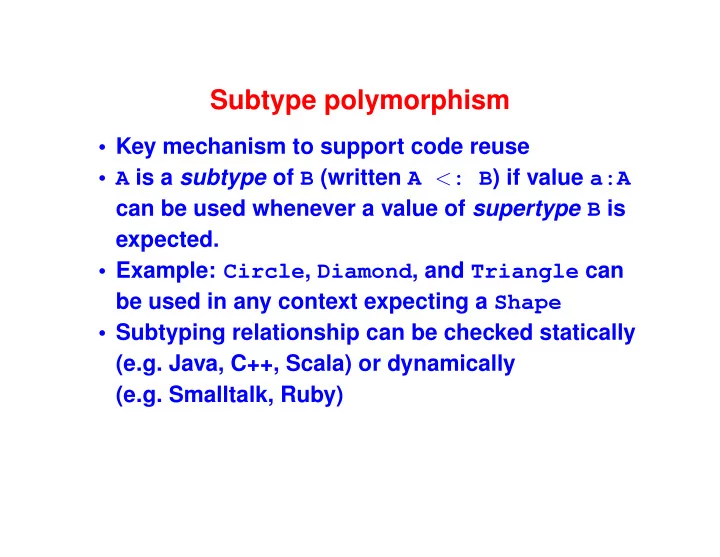

Subtype polymorphism • Key mechanism to support code reuse • A is a subtype of B (written A < : B ) if value a:A can be used whenever a value of supertype B is expected. • Example: Circle , Diamond , and Triangle can be used in any context expecting a Shape • Subtyping relationship can be checked statically (e.g. Java, C++, Scala) or dynamically (e.g. Smalltalk, Ruby)
Subtyping mathematically Always transitive � 1 � 2 � 2 � 3 < : < : � 1 � 3 < : Key rule is subsumption: � ′ e : � � < : e � ′ : ( implicit : not marked in code with a cast)
Subtype understands more messages f m 1 ; m n ; m n + k f m 1 ; m n � n � n + k � n � 1 � 1 : ; : : : : ; : : : : g < : : ; : : : : g If an object understands messages m 1 ; m n , and ; : : : maybe more, you can use it in any context expecting only m 1 ; m n . ; : : :
Behavioral subtyping (in Ruby, “duck typing”) Types aren’t enough: • Methods should also behave as expected. Example: • draw method in Shape hierarchy vs. • draw method in first-person shooter game Not enforced in type systems because of decidablity.
Subtyping is not inheritance - **SUBTYPE != SUBCLASS** - **SUPERTYPE != SUPERCLASS** Some languages like C++ identify subtype with subclass, but conceptually they are different.
Examples Example: circle and square with same protocol but defined independently • Subtypes but not related via inheritance Example: Non-mutable dictionary that inherits from Dictionary but hides all methods that can update entries • Related via inheritance but not subtypes
Subtyping and Inheritance: Code Reuse What reuse is being enabled? • Inheritance: Parent code to facilitate class definition • Subtyping: All the client code Food for thought: Which has the bigger impact?
When are two entities equal? • Easy to get wrong esp. for abstract types • Logically equal but have different reps Example: lists used to represent sets [1,2,3] and [2,1,3] • Logically distinct by have the same rep Example: Simulation of an ecosystem Two distinct animals may have same data
Different answers for different types
Scalars Examples: int , bool , char , etc. Test: Same bit representation • Efficient • But: Don’t use for floats!
Functions Example: int * int list - > int list Test: Same code? • Decidable, but meaningful? Test: Same math function? • Undecideable • Reason for ML’s ''a types: any type that supports equality Usually disallowed.
Compound types: Option 1 Examples: • a dict object from class Dictionary • a rabbit from a simulation class Test: object identity • Same object in memory • Very efficient • May fail to equate things that should be equal
Compound types: Option 2 Examples: • a dict object from class Dictionary • a rabbit from a simulation class Test: structural equality • Recursively examine all the parts • Can be expensive! • Less picky, but may also fail to equate things that should be equal
Compound types: Option 3 Examples: • a dict object from class Dictionary • a rabbit from a simulation class Test: User-defined • Can precisely define correct notion of equality • May or may not be efficient • Requires programmer attention
Tension Correctness vs. Efficiency vs. Programmer Convenience
Observational equivalence Key idea: observational equivalence • Two values should be considered equal if no context can tell them apart
Key question: What should the context be allowed to do? • If context can use reflection (eg, class methods to query object formation), then no abstraction – Rule out reflection • Internals of an abstraction can see more than intended – Only let context use client code • If object is mutable and context is allowed to mutate it – either: Object identity – or: Rule out mutation
Equality in uSmalltalk Method == is object identity ;; object identity (method == (anObject) (primitive sameObject self anObject)) Method = is a form of observational equivalence • Principle: Two objects are considered equivalent if, without mutating either object, client code cannot tell them apart • Each class decides for itself by overwriting default method • Defaults to object identity (method = (anObject) (self == anObject)) • Used by check-expect • Why disallow client code from using mutation to observe? Pragmatic: already have object-identity with = method
Example: Equivalent but not equal (-> (val ns (List new)) List( ) -> (ns addFirst: 3) -> (ns addFirst: 2) -> (ns addFirst: 1) -> ns List( 1 2 3 ) -> (val ms (List new)) List( ) -> (ms addLast: 1) -> (ms addLast: 2) -> (ms addLast: 3) -> ms List( 1 2 3 ) -> (ns == ms) <False> -> (ns = ms) <True>
The design process with objects Key adaptations to design steps: 1. Forms of data still work (but we see only our own) 4. Contracts are critical 6. Algebraic laws still help: – FP: law is a clause in a function – OOP: law is a method on a class 7. Code case analysis: right method on right class 8. Code results: look at own instance variables, send messages to others (asymmetric)
How to approach object-orientation What to remember: • Dynamic dispatch tells your own form of data • Avoid knowing any argument’s form! Use semi-private methods, or (last resort) double dispatch What not to do: • Don’t guess what code will answer a message • Don’t try to trace follow procedures step by step (crosses too many class/method boundaries) What to do instead: • Trust the contract • Keep each method dirt simple
Recommend
More recommend